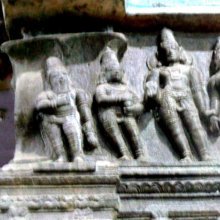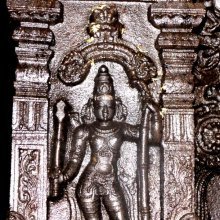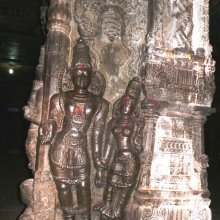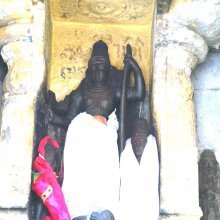Shitadevi, Śitādēvī, Śitādevī, Sita-devi: 1 definition
Introduction:
Shitadevi means something in Hinduism, Sanskrit, Marathi. If you want to know the exact meaning, history, etymology or English translation of this term then check out the descriptions on this page. Add your comment or reference to a book if you want to contribute to this summary article.
The Sanskrit terms Śitādēvī and Śitādevī can be transliterated into English as Sitadevi or Shitadevi, using the IAST transliteration scheme (?).
Images (photo gallery)
(+4 more images available)
In Hinduism
Vaishnavism (Vaishava dharma)
Source: Pure Bhakti: Brhad BhagavatamrtamSītādevī (सीतादेवी) refers to:—The daughter of Janaka Mahārāja and the eternal consort of Śrī Rāmacandra. (cf. Glossary page from Śrī Bṛhad-bhāgavatāmṛta).

Vaishnava (वैष्णव, vaiṣṇava) or vaishnavism (vaiṣṇavism) represents a tradition of Hinduism worshipping Vishnu as the supreme Lord. Similar to the Shaktism and Shaivism traditions, Vaishnavism also developed as an individual movement, famous for its exposition of the dashavatara (‘ten avatars of Vishnu’).
Languages of India and abroad
Marathi-English dictionary
Source: DDSA: The Molesworth Marathi and English Dictionaryśitādēvī (शितादेवी).—f Properly sītādēvī.
--- OR ---
sītādēvī (सीतादेवी).—f (sītā in the sense of Pomona.) The portion of a crop left (at reaping-time) in a corner for the Mahar. Applied, in some districts, to the remnant upon the khaḷēṃ or thrashing floor after the removal of the rāsa or corn-heap. A hakk of the Mahar.
Marathi is an Indo-European language having over 70 million native speakers people in (predominantly) Maharashtra India. Marathi, like many other Indo-Aryan languages, evolved from early forms of Prakrit, which itself is a subset of Sanskrit, one of the most ancient languages of the world.
See also (Relevant definitions)
Partial matches: Devi, Sita, Tevi.
Full-text: Candramas, Siddhavata, Sita, Kimpurushavarsha, Janakpur.
Relevant text
Search found 15 books and stories containing Shitadevi, Sita-devi, Sītā-devī, Śitādēvī, Śitādevī, Sitadevi, Sītādēvī, Sītādevī; (plurals include: Shitadevis, devis, devīs, Śitādēvīs, Śitādevīs, Sitadevis, Sītādēvīs, Sītādevīs). You can also click to the full overview containing English textual excerpts. Below are direct links for the most relevant articles:
Srila Gurudeva (The Supreme Treasure) (by Swami Bhaktivedanta Madhava Maharaja)
Indications of Departure < [Chapter 2.19 - The Concluding Transcendental Pastimes]
Śrīla Gurudeva’s inclination as a Boy < [Chapter 1.2 - Śrīla Gurudeva’s Pūrvāśrama]
Disciple’s Main identification is Guru-Parampara < [Chapter 1.2 - Śrīla Gurudeva’s Pūrvāśrama]
Garga Samhita (English) (by Danavir Goswami)
Verse 5.20.14 < [Chapter 20 - The Liberation of Ṛbhu Muni During the Rāsa-dance Festival]
Verse 5.11.3 < [Chapter 11 - The Stories of Kubjā and Kuvalayāpīḍa]
Verse 5.16.11 < [Chapter 16 - Comforting Sri Radha and the Gopis]
The Devi Bhagavata Purana (by Swami Vijñanananda)
Chapter 29 - On the stealing of Sītā and the sorrows of Rāma < [Book 3]
Chapter 28 - On the incidents connected with Navarātri < [Book 3]
Brihad Bhagavatamrita (commentary) (by Śrī Śrīmad Bhaktivedānta Nārāyana Gosvāmī Mahārāja)
Verse 2.4.259 < [Chapter 4 - Vaikuṇṭha (the spiritual world)]
Verse 1.4.44 < [Chapter 4 - Bhakta (the devotee)]
Verse 1.4.49 < [Chapter 4 - Bhakta (the devotee)]
Who’s Who Among our Contributors < [January – March, 2001]
Book Reviews < [January – March, 1996]
Our Contributors < [October – December, 1995]
Chaitanya Bhagavata (by Bhumipati Dāsa)
Verse 2.11.51 < [Chapter 11 - The Characteristics of Nityānanda]
Verse 1.15.195 < [Chapter 15 - Marriage with Śrī Viṣṇupriyā]
Verse 2.10.148 < [Chapter 10 - Conclusion of the Lord’s Mahā-prakāśa Pastimes]





